We had so much fun rolling cakes in pastry class the other night. And no, we didn’t roll them along the floor like so many bowling balls, silly. We learned to make roulades, which is just a fancy way of saying we rolled them into swirly designs with fillings.
One type of roulade was familiar to me: the kind that looks like a log when it’s all done, and each round slice has a neat little spiral design in it, like I showed you the other night:
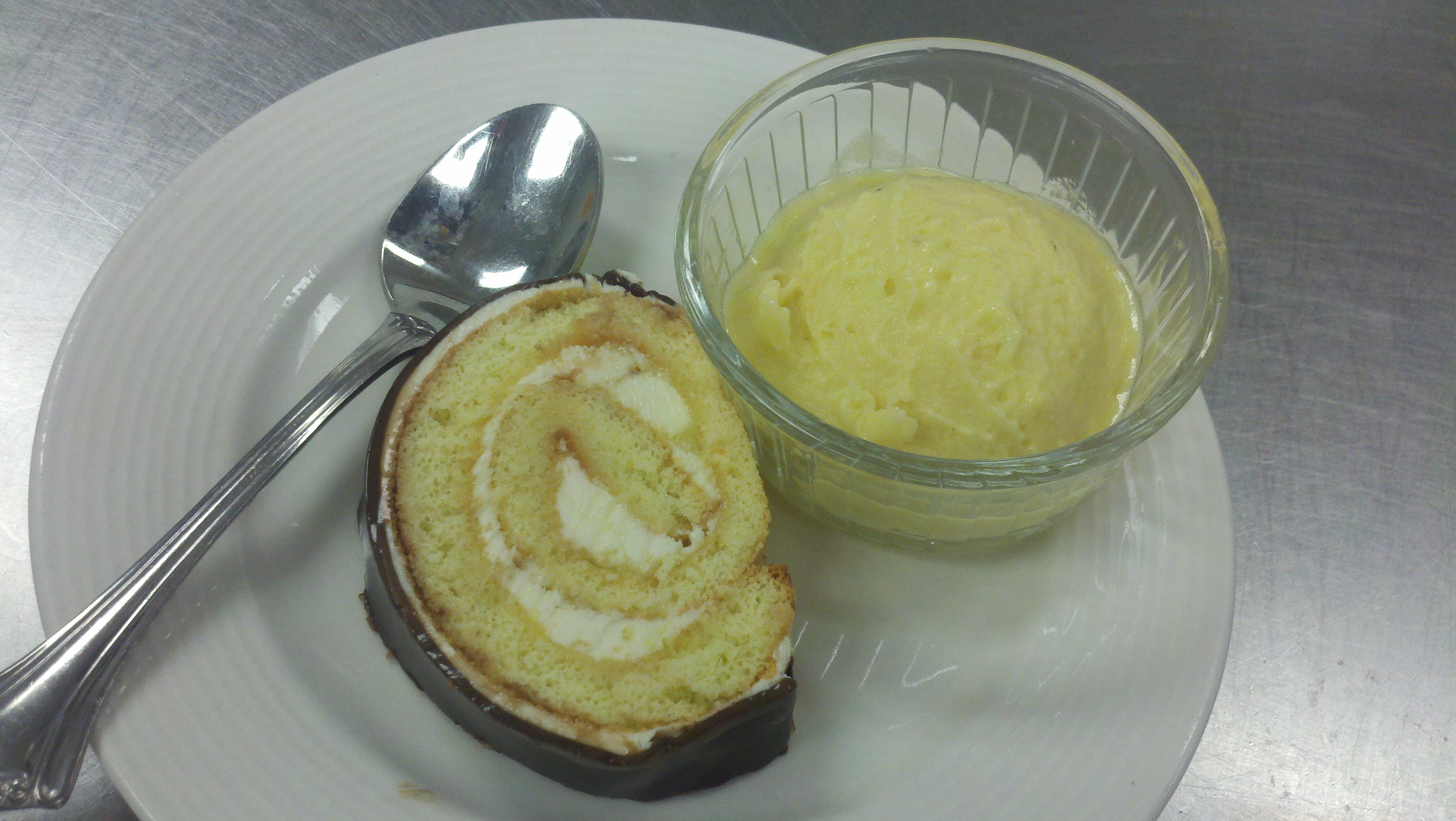 The other type came as a surprise to me, so I want to tell you about it, since I’m guessing it will be a surprise to you, too. It’s called zebra cake, and it has a lovely exotic look:
The other type came as a surprise to me, so I want to tell you about it, since I’m guessing it will be a surprise to you, too. It’s called zebra cake, and it has a lovely exotic look:
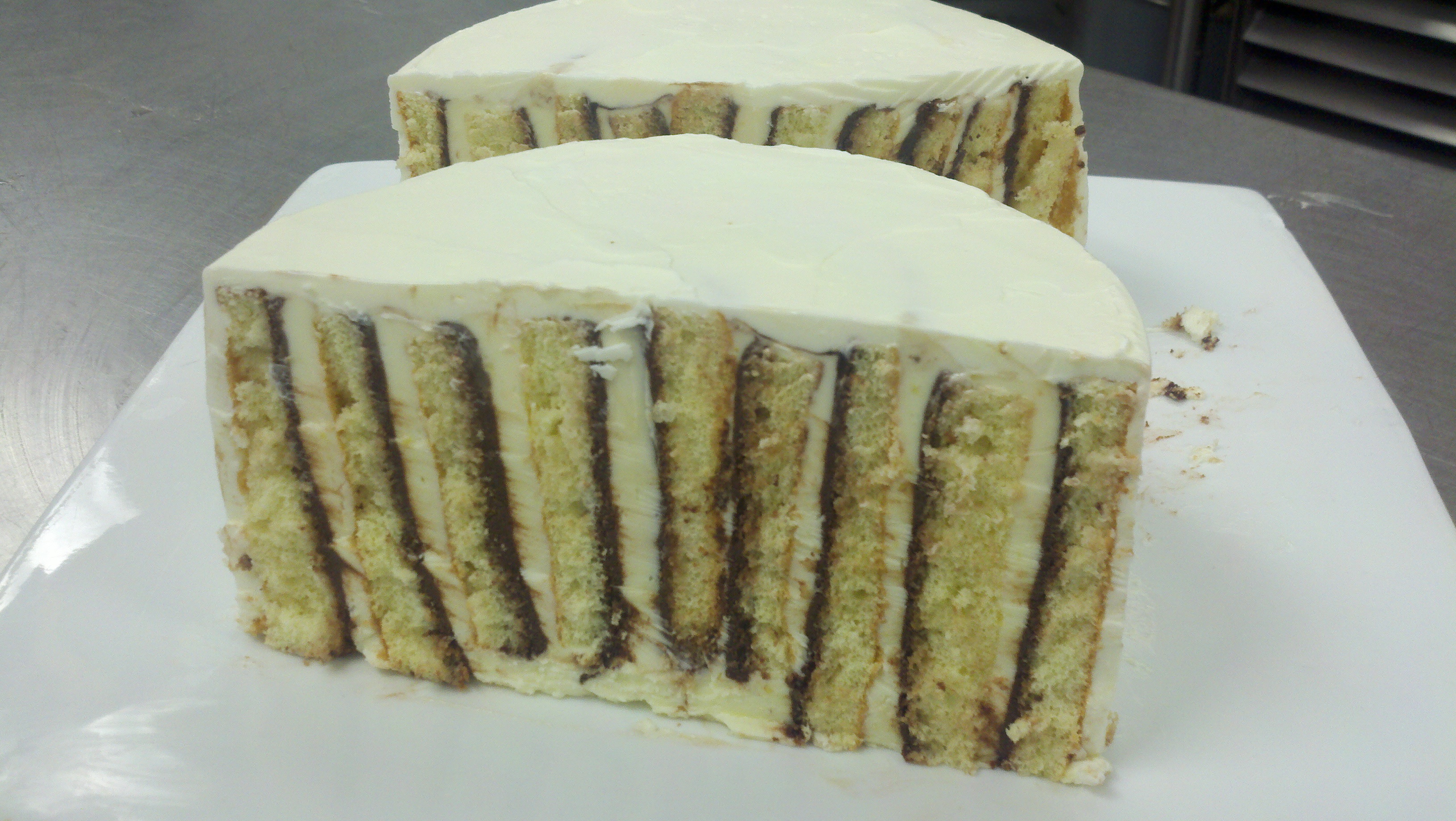 How do you get that pattern? Here’s how:
How do you get that pattern? Here’s how:
You start with a nice yellow cake batter (or whatever flavor you want, obviously; we used yellow cake) and you spread it very, very evenly in half-sheet pans. Chef Claude explained that you have to take extra care to smooth this batter, and to check that it’s evenly spread, since it pretty much stays put when it bakes.
These cakes bake up pretty thin. Take a look:
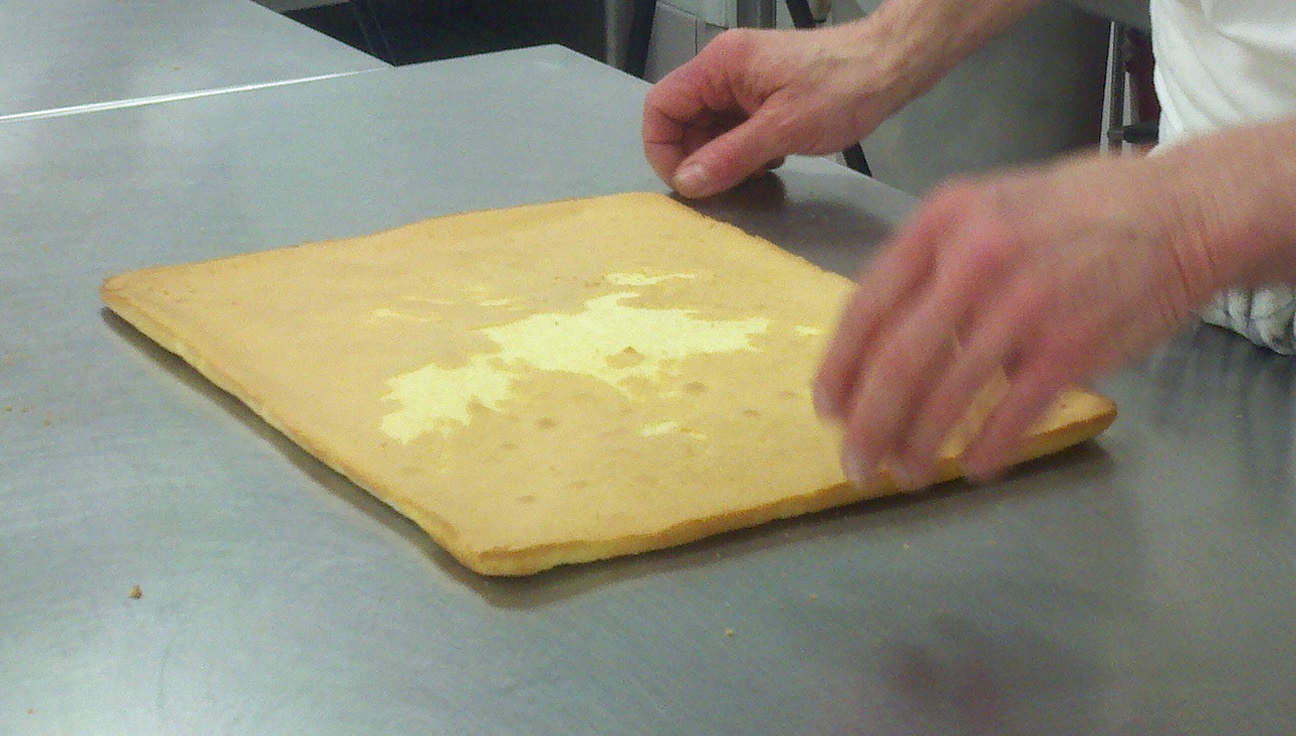 Chef applied a little simple syrup (equal parts sugar and water, or some close variation)…
Chef applied a little simple syrup (equal parts sugar and water, or some close variation)… 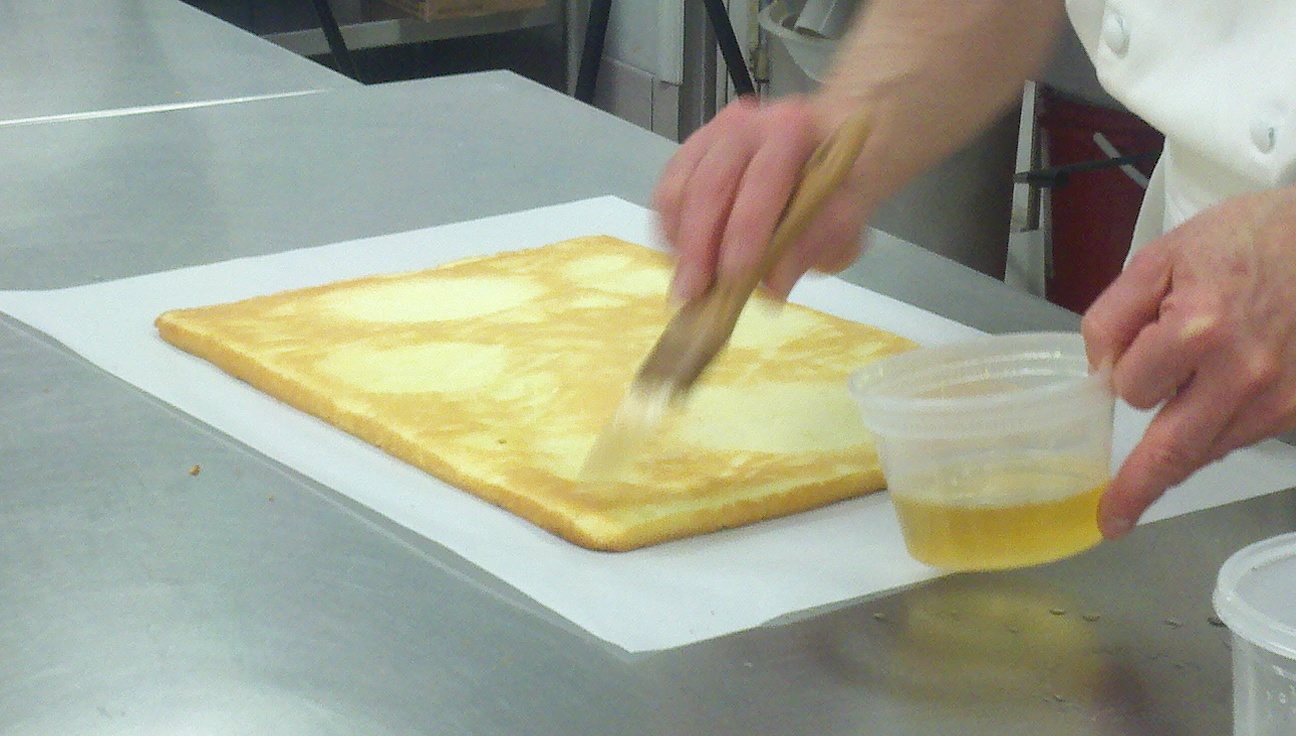
and then layers of ganache and buttercream…
… and then he cut the cake into 2-inch-wide sections.
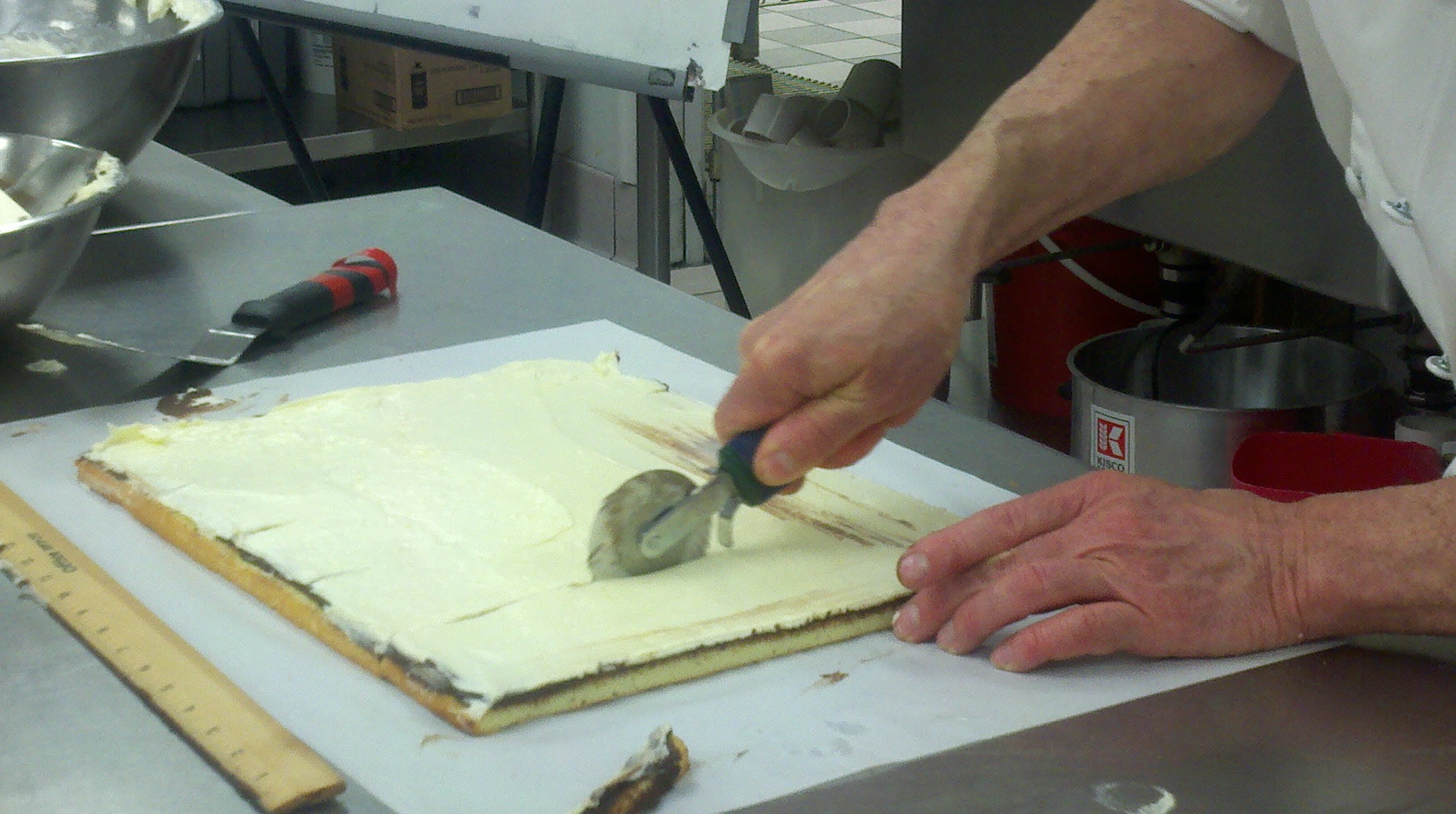 He rolled one of those 2-inch sections up, and set it on top of the flat 2-inch section next to it. Then he rolled those together, and kept doing that until he had all the cake sections rolled together.
He rolled one of those 2-inch sections up, and set it on top of the flat 2-inch section next to it. Then he rolled those together, and kept doing that until he had all the cake sections rolled together.
Chef Claude then set the rolled cake on its swirled edge, where it looked remarkably like a normal cake (which it wasn’t, of course). He circled it with a band of plastic wrap so it could slide into the fridge to firm up:
 When it came out, Chef applied a thin coat of buttercream, called a “crumb coat” because it protects the second layer of buttercream from picking up loose crumbs.
When it came out, Chef applied a thin coat of buttercream, called a “crumb coat” because it protects the second layer of buttercream from picking up loose crumbs.
When the buttercream was done and all smoothed out, he cut it for us to show us the dramatic interior, as you saw at the beginning of this post. Quite the flamboyant little cake!
Making our more-typical roulades began in a similar way, by making a yellow cake batter and spreading it thin on half-sheet pans. When they were baked, we laid them out on sheets of parchment and brushed on a little simple syrup, lemon curd and buttercream.
Then we used the parchment underneath them to help us roll the cakes: we lifted the edge that was farthest away from us, angling the paper toward us and using our fingers just a little to help the edge of the cake to begin the roll. Here’s Chef Claude showing us how:
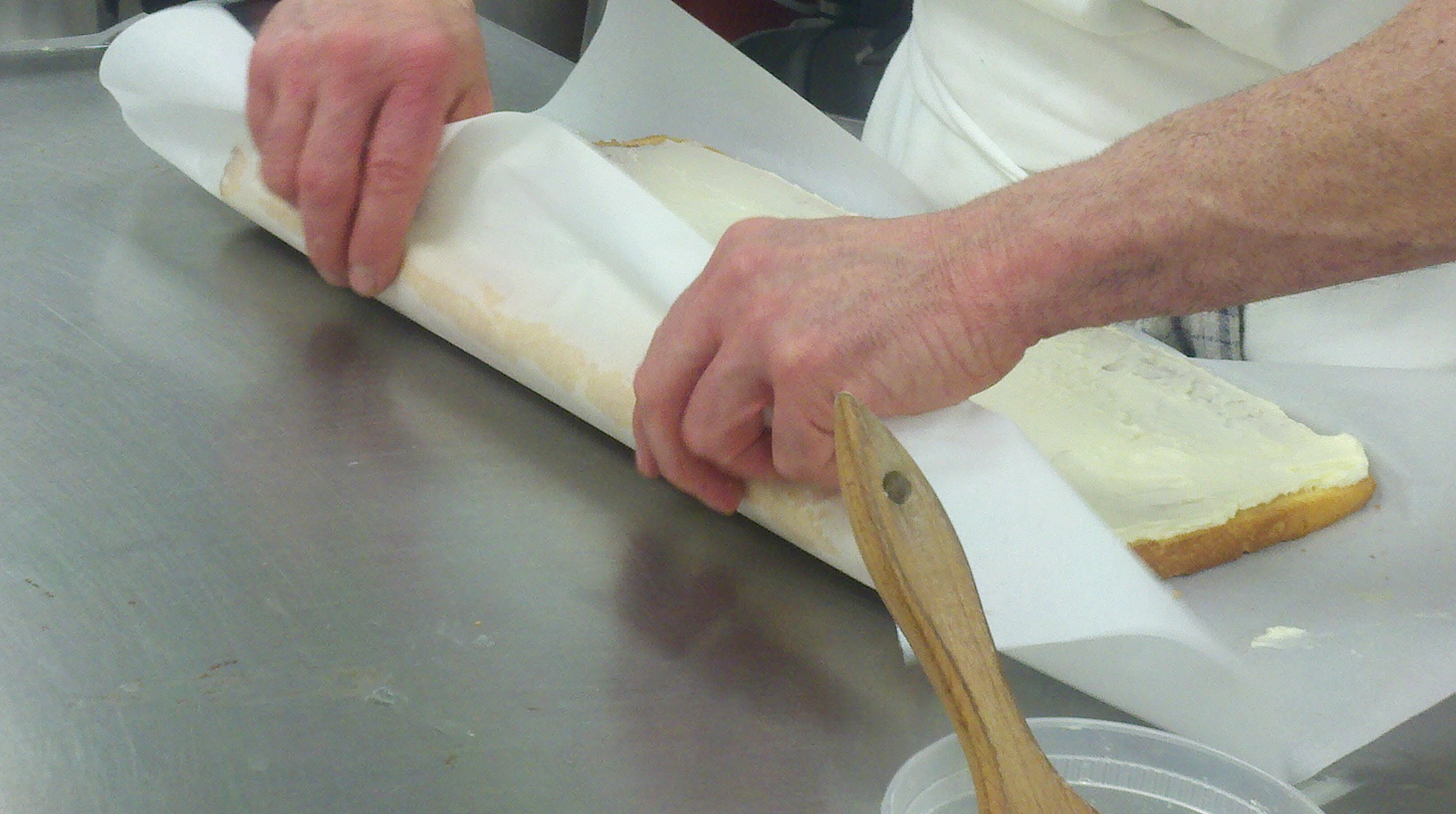 When we had rolled up our cakes, we tucked the parchment around the roll snugly, and used a yardstick to push back against the paper-wrapped roll, to get it nice and tight.
When we had rolled up our cakes, we tucked the parchment around the roll snugly, and used a yardstick to push back against the paper-wrapped roll, to get it nice and tight.
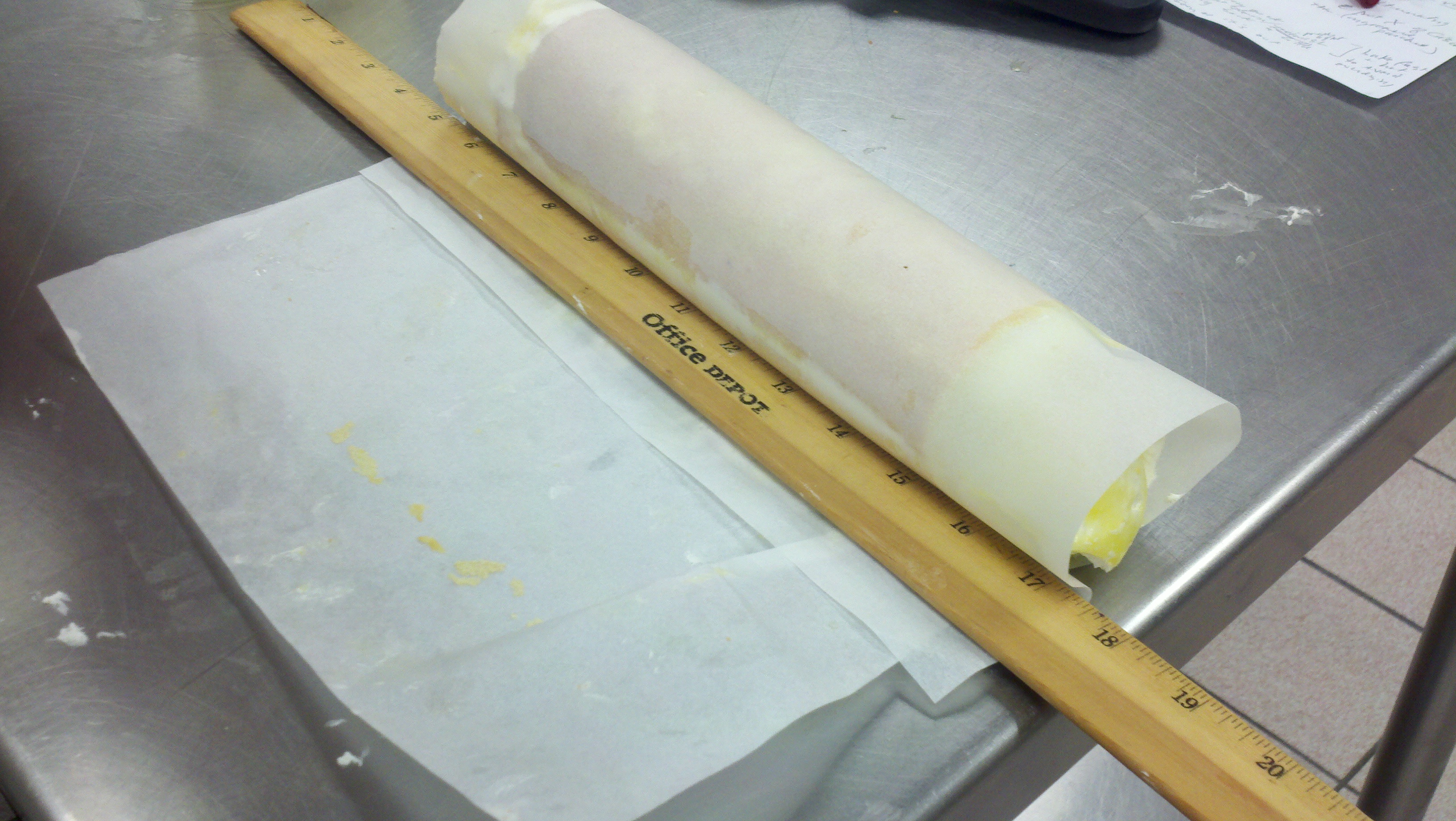 When the roulades were built, it was time for a crumb coat:
When the roulades were built, it was time for a crumb coat:
 And we needed to make sure that coat was very smooth, so it wouldn’t make ugly bumps under the ganache glaze that would come next. To do this, Chef showed us how to use a strip of parchment, curving it over the roulade and drawing it along its length to smooth out the buttercream.
And we needed to make sure that coat was very smooth, so it wouldn’t make ugly bumps under the ganache glaze that would come next. To do this, Chef showed us how to use a strip of parchment, curving it over the roulade and drawing it along its length to smooth out the buttercream.
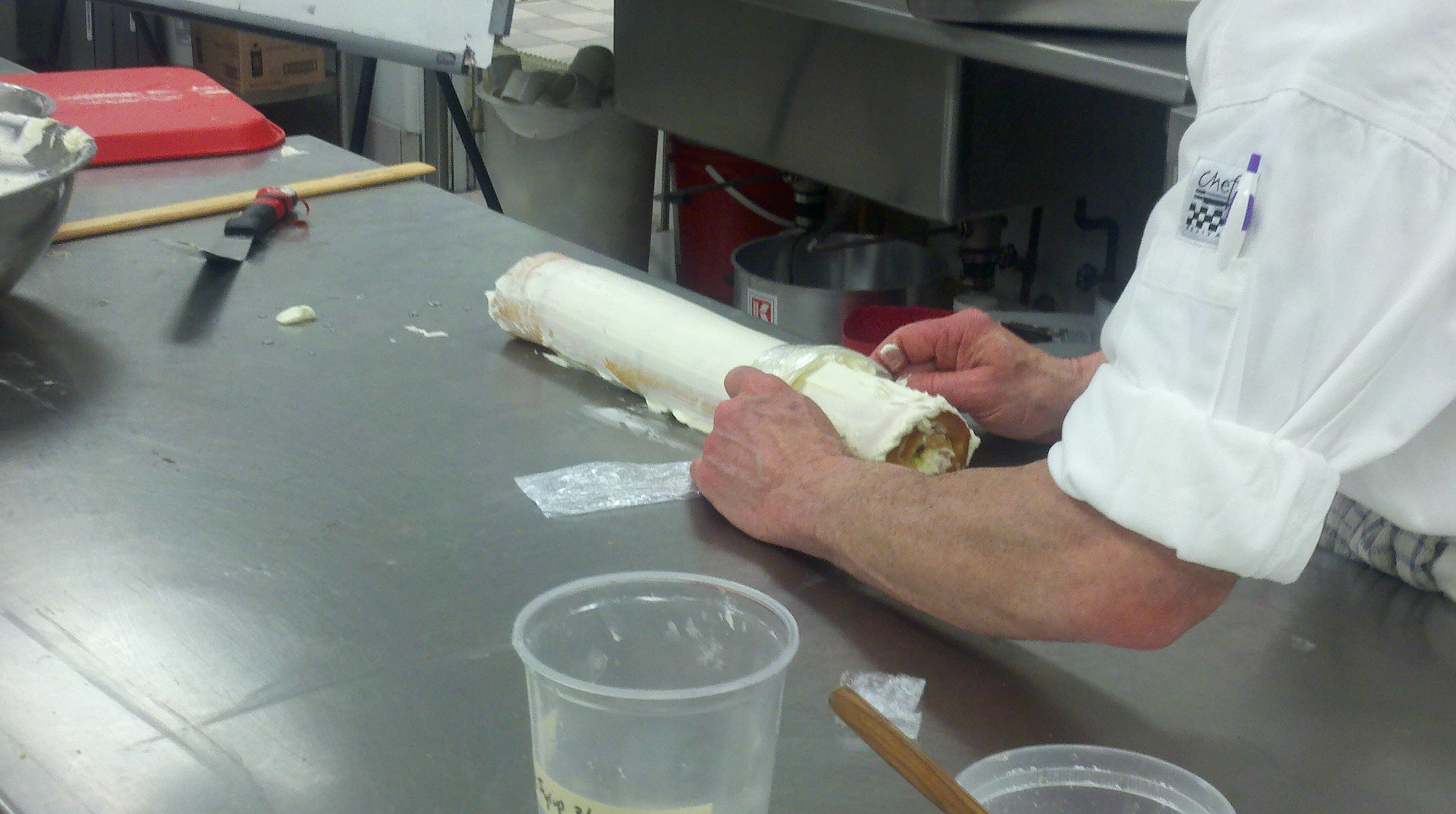 Then it was time for the ganache (remember? one part chocolate, one part heavy cream). Chef did this part for us: he put our roulades on a cooling rack that was positioned over a half-sheet pan, and poured the glaze on:
Then it was time for the ganache (remember? one part chocolate, one part heavy cream). Chef did this part for us: he put our roulades on a cooling rack that was positioned over a half-sheet pan, and poured the glaze on:
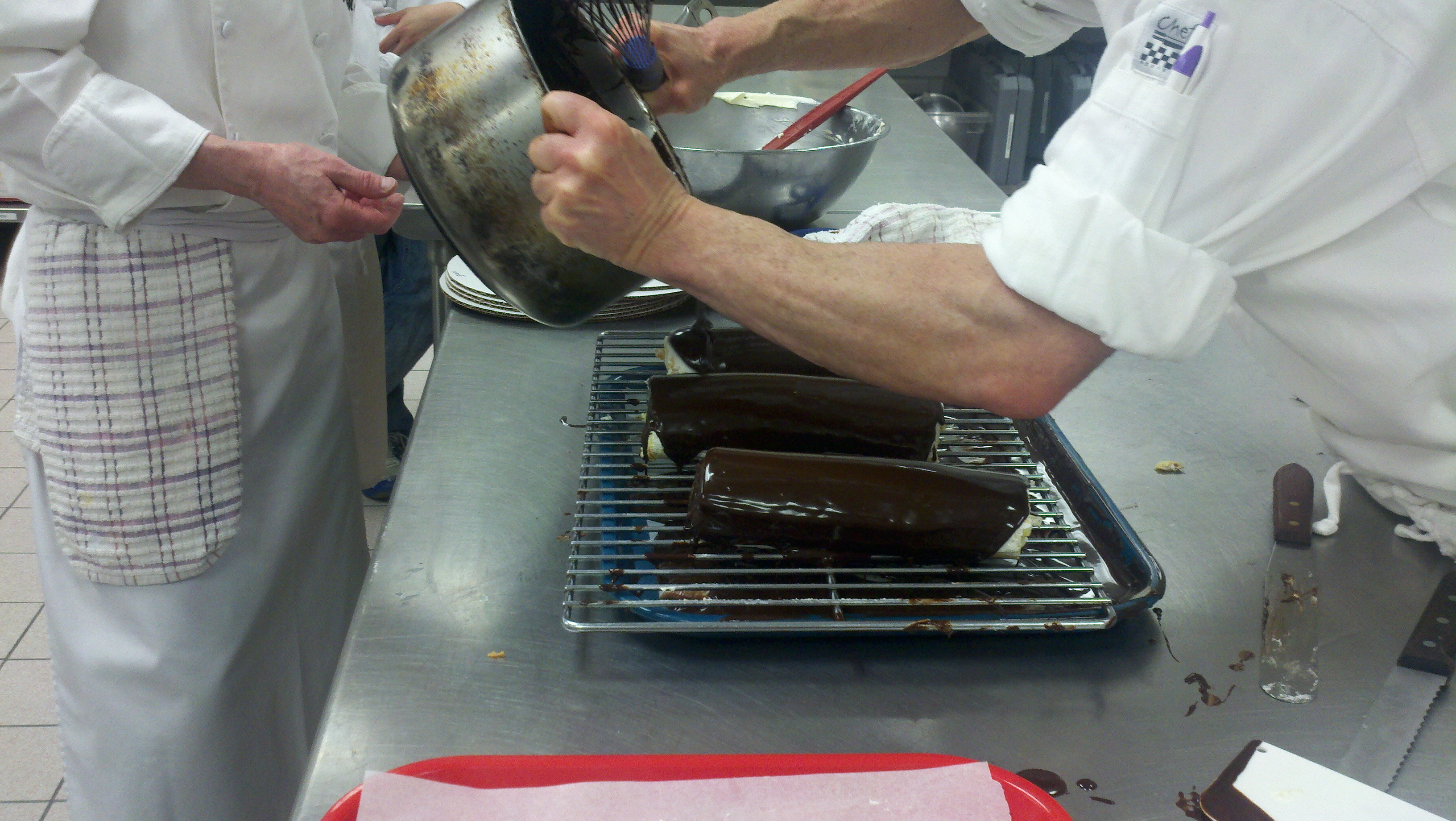 And here is how one roulade looks posing for its closeup:
And here is how one roulade looks posing for its closeup:
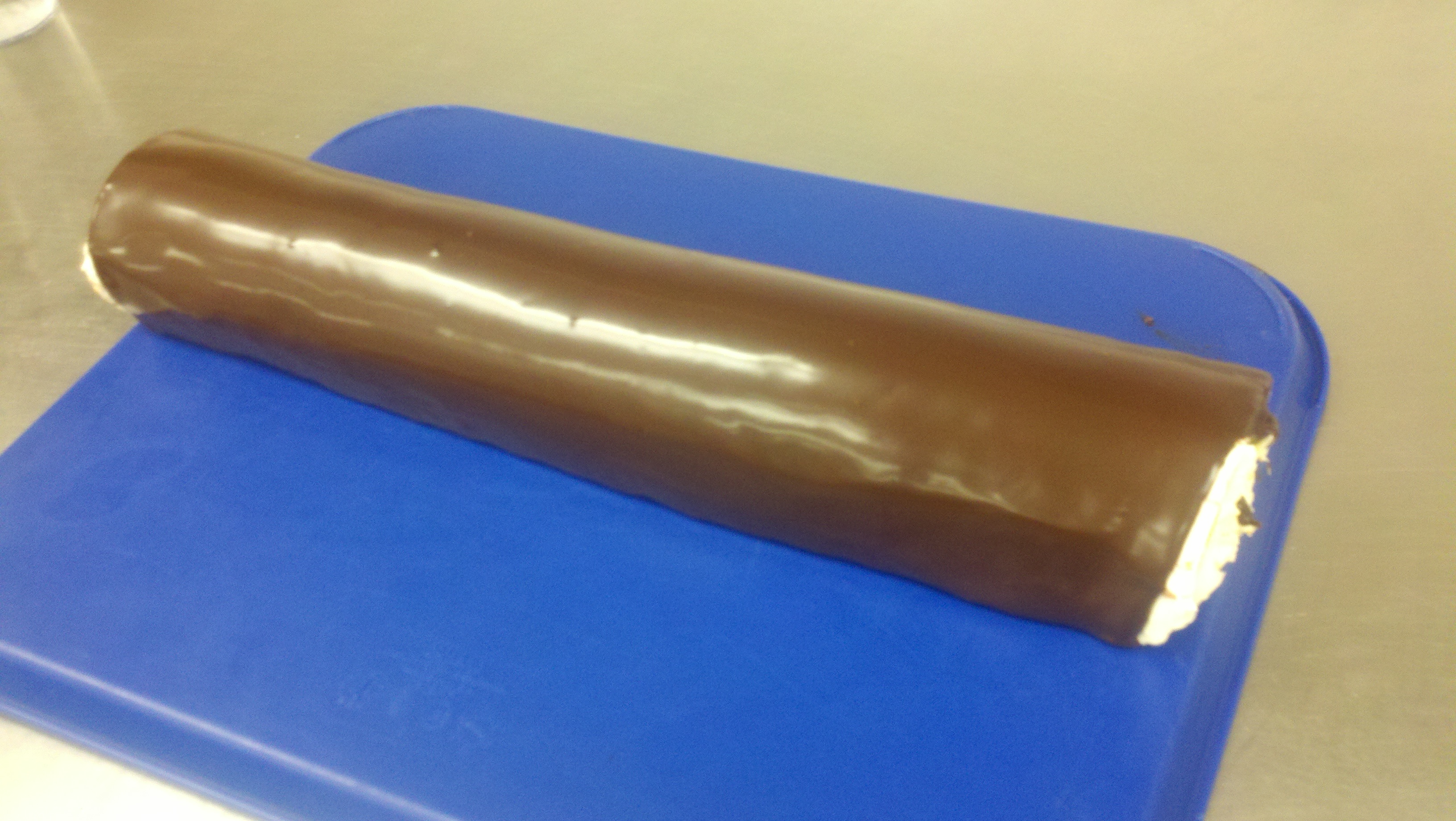 You already saw how enticing a single serving looks, but it’s worth showing you again; perhaps you’ll be inspired to make one!
You already saw how enticing a single serving looks, but it’s worth showing you again; perhaps you’ll be inspired to make one!
 That’s banana-passion fruit sorbet in the little bowl. Chef used to make that when he worked for Michel Richard at Citronelle here in D.C. It was lovely! And so easy to make: he threw bananas, passion-fruit puree, sugar and water in a blender and froze it.
That’s banana-passion fruit sorbet in the little bowl. Chef used to make that when he worked for Michel Richard at Citronelle here in D.C. It was lovely! And so easy to make: he threw bananas, passion-fruit puree, sugar and water in a blender and froze it.
Here is the recipe for the yellow cake we used for the log-shaped roulade (“bisquit roulade”) and the zebra cake. It is really lovely; tender and fine-grained.
Vanilla Roulade
8 egg yolks
4 oz. sugar
8 egg whites
4 additional ounces of sugar
7 oz. sifted cake flour (first measure by weight, then sift)
Combine 4 oz. sugar with egg yolks and 1 Tbsp. of water in the bowl of a stand mixer with whisk attachment. Beat until very light in color. This could take 4 to 5 minutes.
Separately, beat the egg whites with the whisk attachment. When they have lost their yellowish color and are clear, add the other 4 oz. of sugar. Beat until the meringue is just short of the soft-peak stage. The peaks should be droopy.
Fold the meringue mixture into the yolks mixture, alternating additions of meringue with additions of sifted flour.
Prepare two half-sheet pans: Make an X of Crisco on the baking surface, and put down a sheet of parchment, so the Crisco X holds it securely. Grease the sides of the pan with Crisco.
Divide the batter into the two half-sheet pans, and smooth the surface with an offset spatula. Use your thumb to clear any batter from the pan’s sides.
Bake at 400 degrees until the cakes are very light brown and spring back slightly to the touch. This will take only a few minutes. Unmold the cakes from the pans as soon as they come out of the oven.
For the buttercream, we used a lighter version than the one we used a couple weeks ago (buttercream recipe is all the way at the bottom!). Chef Claude’s lighter version has less butter and more egg white. The technique is the same for both versions, so go ahead and use the instructions from my earlier posting. But here are the ingredients for the lighter version:
Chef Claude’s Lighter Italian Meringue Buttercream
16 oz. sugar, divided (use 1 oz to beat with the egg whites, and 15 oz. with the water to cook into syrup)
1/2 c. water
1 Tbsp. Karo syrup (optional, and we didn’t use it)
8 oz. egg whites
16 oz. unsalted butter, room temperature, cut into 1-inch-square cubes
1-2 tsp. vanilla

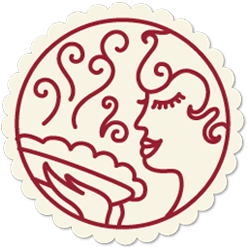
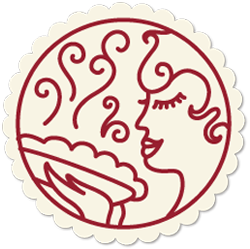

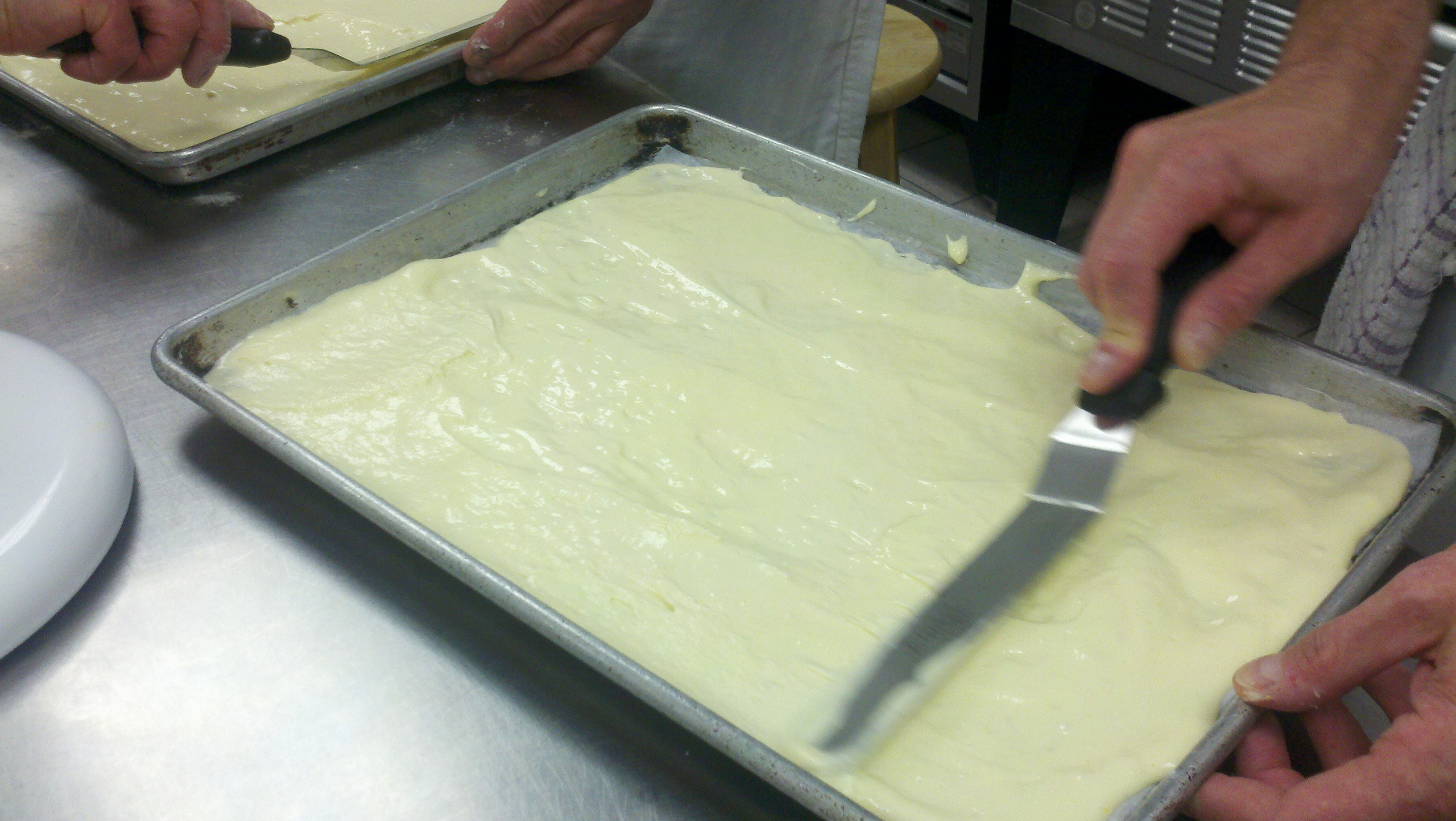

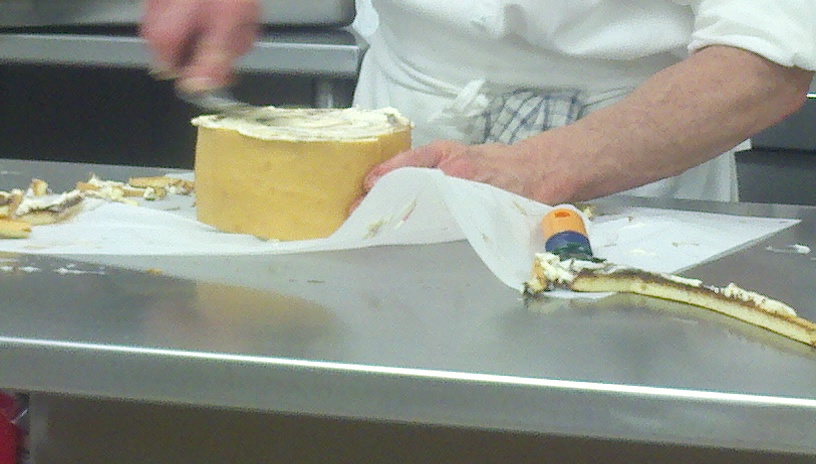
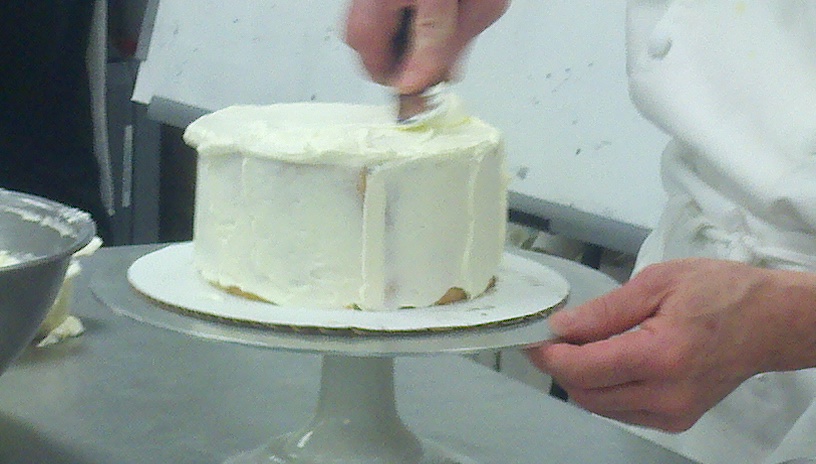
Wow on all fronts. The zebra cake really knocked me out. So creative. I really cannot bake, but the sheer thinking going into this cake-rolling thing is outta this world.
Oh, and the banana-passion fruit sorbert…OMG, I’m salivating at my desk!
Beautiful.